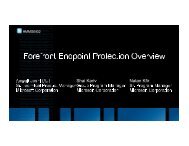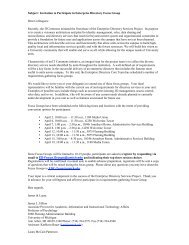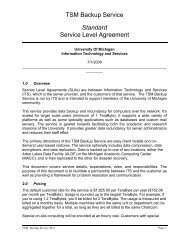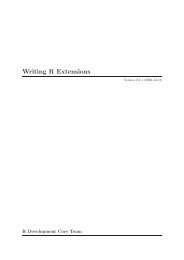What documentation exists for R?
What documentation exists for R?
What documentation exists for R?
You also want an ePaper? Increase the reach of your titles
YUMPU automatically turns print PDFs into web optimized ePapers that Google loves.
Chapter 7: R Miscellanea 83<br />
title(bquote(hat(a) = .(ahat)))<br />
where subexpressions enclosed in ‘.()’ are replaced by their values.<br />
There are more worked examples in the mailing list achives.<br />
7.14 <strong>What</strong> are valid names?<br />
When creating data frames using data.frame() or read.table(), R by default ensures<br />
that the variable names are syntactically valid. (The argument ‘check.names’ to these<br />
functions controls whether variable names are checked and adjusted by make.names() if<br />
needed.)<br />
To understand what names are “valid”, one needs to take into account that the term<br />
“name” is used in several different (but related) ways in the language:<br />
1. A syntactic name is a string the parser interprets as this type of expression. It consists<br />
of letters, numbers, and the dot and (<strong>for</strong> version of R at least 1.9.0) underscore<br />
characters, and starts with either a letter or a dot not followed by a number. Reserved<br />
words are not syntactic names.<br />
2. An object name is a string associated with an object that is assigned in an expression<br />
either by having the object name on the left of an assignment operation or as an<br />
argument to the assign() function. It is usually a syntactic name as well, but can be<br />
any non-empty string if it is quoted (and it is always quoted in the call to assign()).<br />
3. An argument name is what appears to the left of the equals sign when supplying an<br />
argument in a function call (<strong>for</strong> example, f(trim=.5)). Argument names are also<br />
usually syntactic names, but again can be anything if they are quoted.<br />
4. An element name is a string that identifies a piece of an object (a component of a list,<br />
<strong>for</strong> example.) When it is used on the right of the ‘$’ operator, it must be a syntactic<br />
name, or quoted. Otherwise, element names can be any strings. (When an object is<br />
used as a database, as in a call to eval() or attach(), the element names become<br />
object names.)<br />
5. Finally, a file name is a string identifying a file in the operating system <strong>for</strong> reading,<br />
writing, etc. It really has nothing much to do with names in the language, but it is<br />
traditional to call these strings file “names”.<br />
7.15 Are GAMs implemented in R?<br />
Package gam from CRAN implements all the Generalized Additive Models (GAM) functionality<br />
as described in the GAM chapter of the White Book. In particular, it implements<br />
backfitting with both local regression and smoothing splines, and is extendable. There is a<br />
gam() function <strong>for</strong> GAMs in package mgcv, but it is not an exact clone of what is described<br />
in the White Book (no lo() <strong>for</strong> example). Package gss can fit spline-based GAMs too. And<br />
if you can accept regression splines you can use glm(). For gaussian GAMs you can use<br />
bruto() from package mda.<br />
7.16 Why is the output not printed when I source() a file?<br />
Most R commands do not generate any output. The command<br />
1+1








